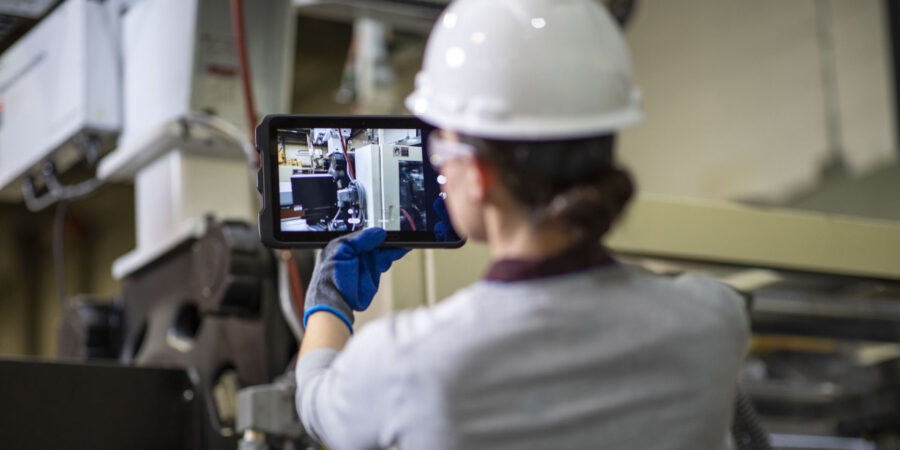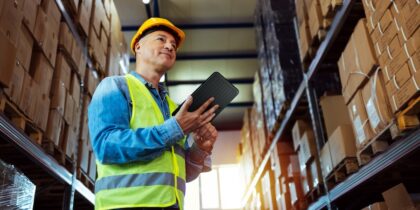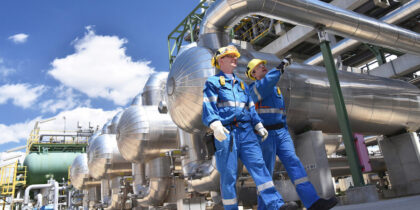According to The Manufacturing Institute’s report, “The Aging of the Manufacturing Workforce,” attracting and retaining a quality workforce is one of the top challenges facing the manufacturing industry today. As the availability of skilled labor in manufacturing continues to worsen and is compounded by both the short- and long-term effects of the COVID-19 pandemic, original equipment manufacturers (OEMs) are looking for ways to increase manufacturing efficiencies by doing more with less.
Lean manufacturing principles, which form the backbone of smart factories, are being increasingly integrated into everyday operations, with impressive results. OEMs that accelerate adoption of lean manufacturing and the transition to data-led practices can increase their competitive edge in a tight labor market.
Here are four ways that manufacturing companies can increase efficiency, leveraging mobile devices to make the gradual transformation into a smart factory:
1. Increase employee productivity
Manufacturing efficiency is all about identifying opportunities to streamline individual processes. This can mean reducing the number of steps required to complete a task through automation, or it can mean untethering employees so they can work from anywhere on the shop floor instead of being tied to a desktop workstation. A smart factory eliminates the paper trail. Digital task management, often done on a mobile device, ensures all jobs are conducted in the right order and by the right employee.
Modernize your factory with mobile
Get your free guide to the mobile technologies that will accelerate your smart factory journey. Download Now
Freeing workers from having to use a desktop increases productivity by cutting down on the distance they must travel to complete a task. Mobile devices that can deliver desktop capabilities on the go enable staff to access enterprise resource planning (ERP) software on the plant floor, eliminating duplicate data entry at the end of the workday.
Keeping up with today’s fast-paced environment is one of the top challenges facing the manufacturing market, but mobile technology is evolving to meet this need. For example, Samsung’s Galaxy Tab Active3, Galaxy Tab Active Pro and Galaxy XCover Pro are built to withstand tough working conditions, like those in a factory, keeping employees productive no matter where they are. For particularly hazardous work environments, Pepperl+Fuchs has created non-incendive variants of several of Samsung’s devices. For example, the Ex-Cover Pro D2 smartphone, built upon the XCover Pro, is designed for use in Division II environments, where workers may be exposed to chemicals that are volatile and flammable.
No environment is too tough for mobile devices nowadays. Providing workers with the tools they need to collaborate, stay safe and deliver higher levels of productivity at the same time is key to maintaining efficiency.
2. Improve asset maintenance
Manufacturing companies cannot afford unplanned downtime. They are turning to lean manufacturing principles such as predictive maintenance to ensure that issues are detected before they result in line stoppage, and that cash flow is not tied up in spare parts that never get used before they get outdated.
Embedded sensors on the manufacturing floor of a smart factory deliver data that is continually processed by on-board processors and fed to algorithms that can predict when a machine is about to break down. When a certain preprogrammed threshold is reached, a trigger can be sent to an employee’s smartphone or wearable. Machine learning ensures that the algorithms work with current data, constantly updating the model and making it smarter over time.
3. Create a digital core
The next industrial revolution, Industry 4.0, uses data as its central currency. Data breaks down silos between departments and allows them increased transparency into processes. In the smart factory, such transparency is the engine for a self-correcting automated manufacturing loop, where all decisions — from which goods to manufacture on any given day to which raw materials are to be reordered — can be executed with minimal intervention from workers. Such automation, driven through data, liberates skilled labor from the more mundane aspects of running a manufacturing pipeline and focuses their efforts on where they are most needed.
Data to create the digital core can flow from a number of discrete sources, including embedded devices on the shop floor and inventory scanners in the warehouse. A centralized system to receive and process data into uniform semantics that can drive operational models will also increase the usefulness of data and drive new insights.
4. Rethink the customer paradigm
To improve manufacturing efficiency, OEMs must work backward from the customer. Why does this matter? In today’s rapid cycle of customer demand and supply, the antiquated and linear design-manufacture-market-sell process does not increase competitive advantage, because demand forecasting is never as effective as ongoing collaboration. When customers are enabled to participate continuously in product design and make updates to their orders, they enjoy a more satisfying, productive relationship.
Pre-COVID-19, many customers already expected digital connectivity with their manufacturers. When the pandemic hit, it was all hands on deck to mitigate supply chain disruption and find alternative manufacturing capabilities that could support a sudden shift to digital-first technologies. As OEMs accelerate product design processes to bring products to market faster in a post-COVID-19 world, the use of digital technologies and factories will be front and center, and both the supply and demand side must work together to ensure critical customer inputs are considered and addressed accurately in the manufacturing process.
It takes a multifaceted approach to increase manufacturing efficiency. But in the age of Industry 4.0, the transition to these data-driven solutions are well within reach, even for OEMs who have been reluctant to jump on the bandwagon. Much can be gained by adopting digital solutions and phasing the transition to a smart factory.
Samsung has an extensive suite of innovative and fully-integrated manufacturing automation solutions that seamlessly transform the physical into real-time, digital intelligence. You can learn more about using mobile technology to modernize your factory with our free white paper.








